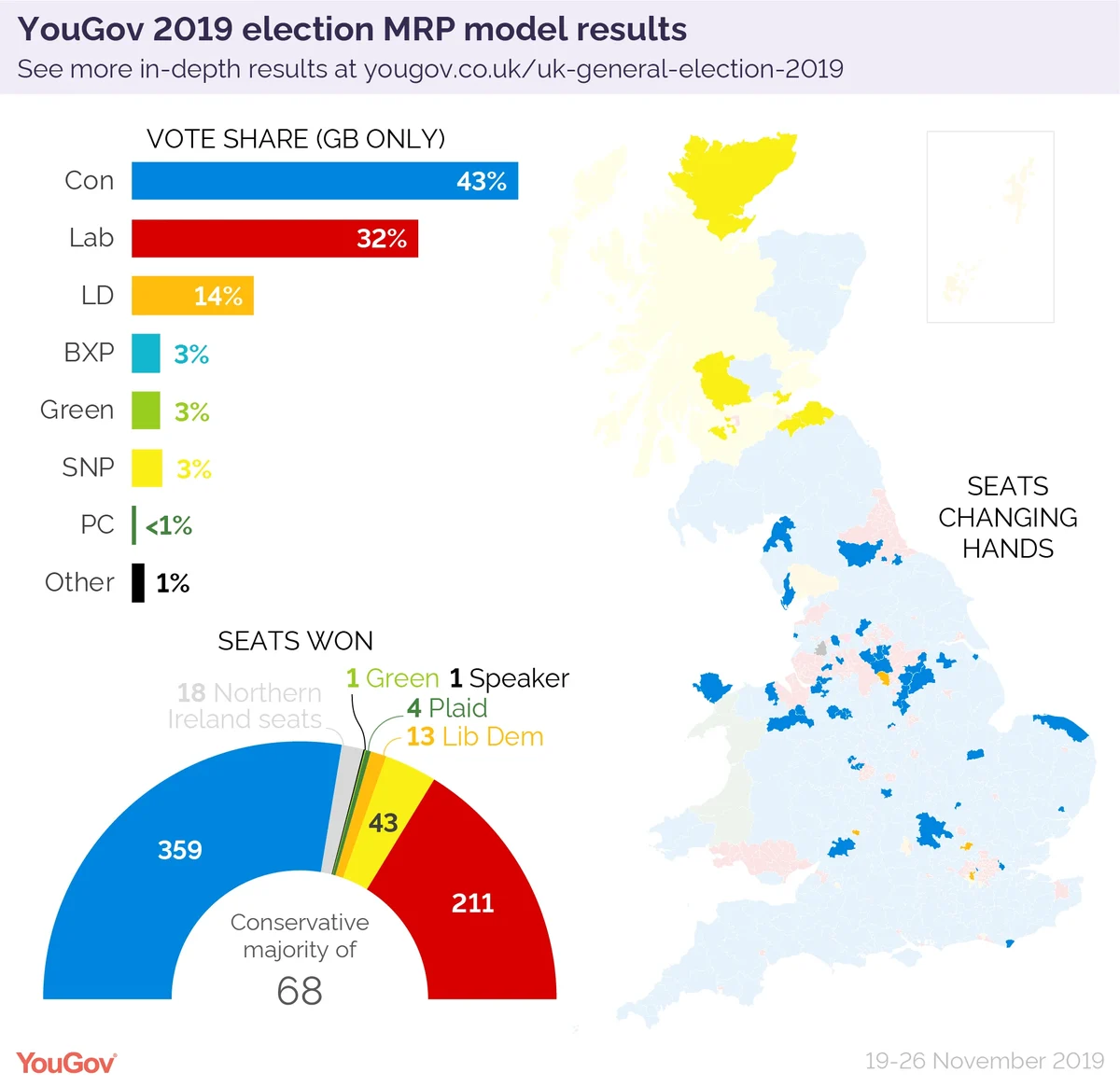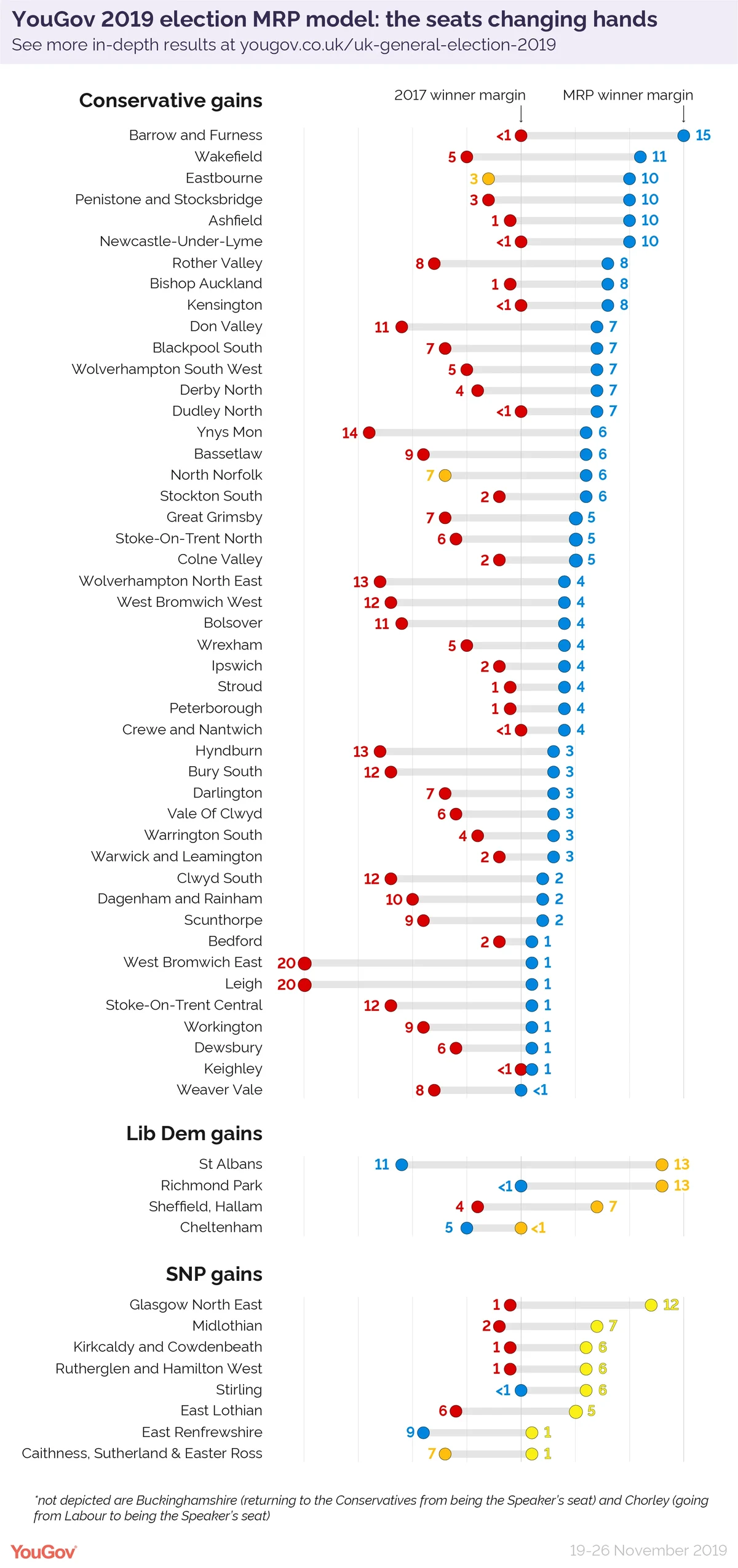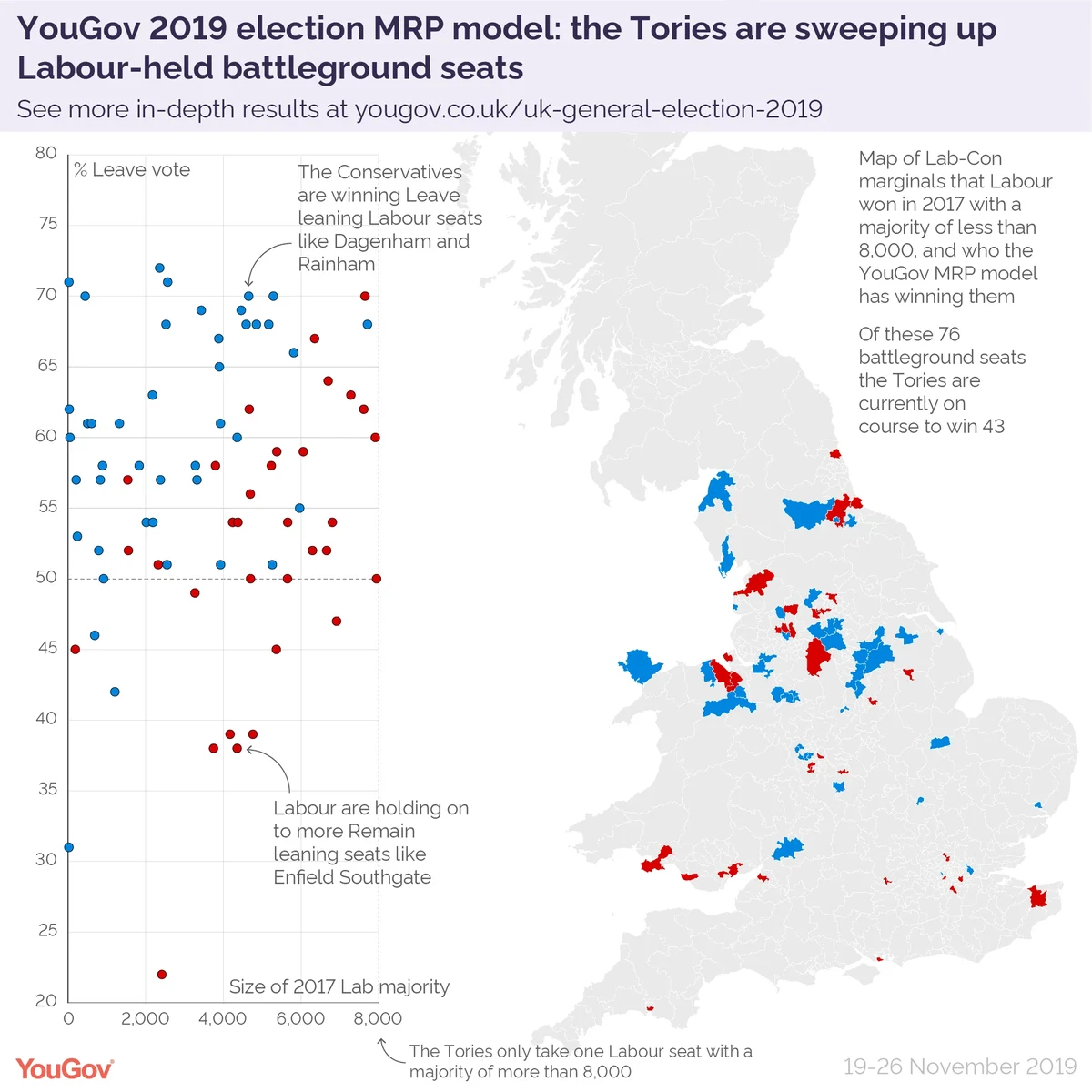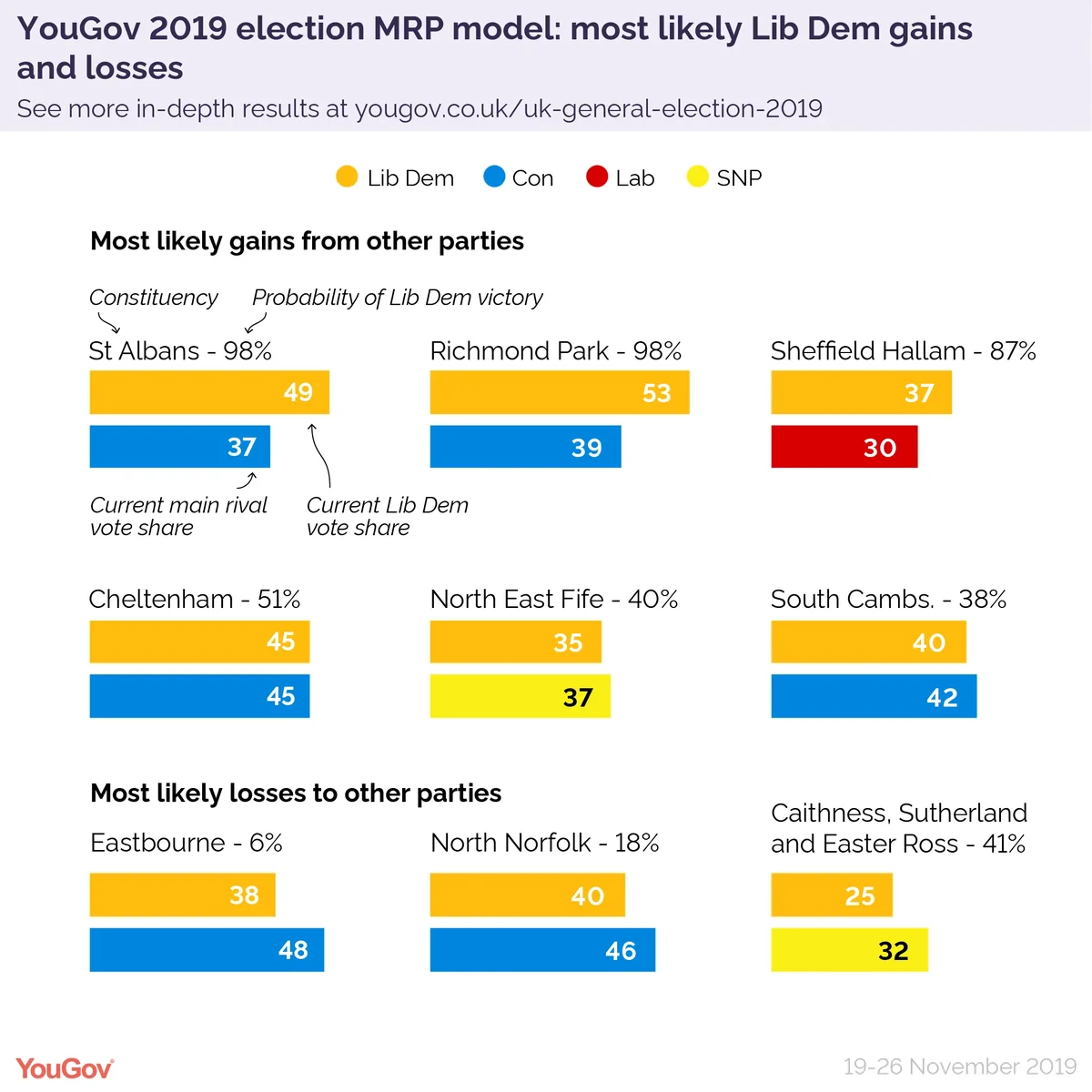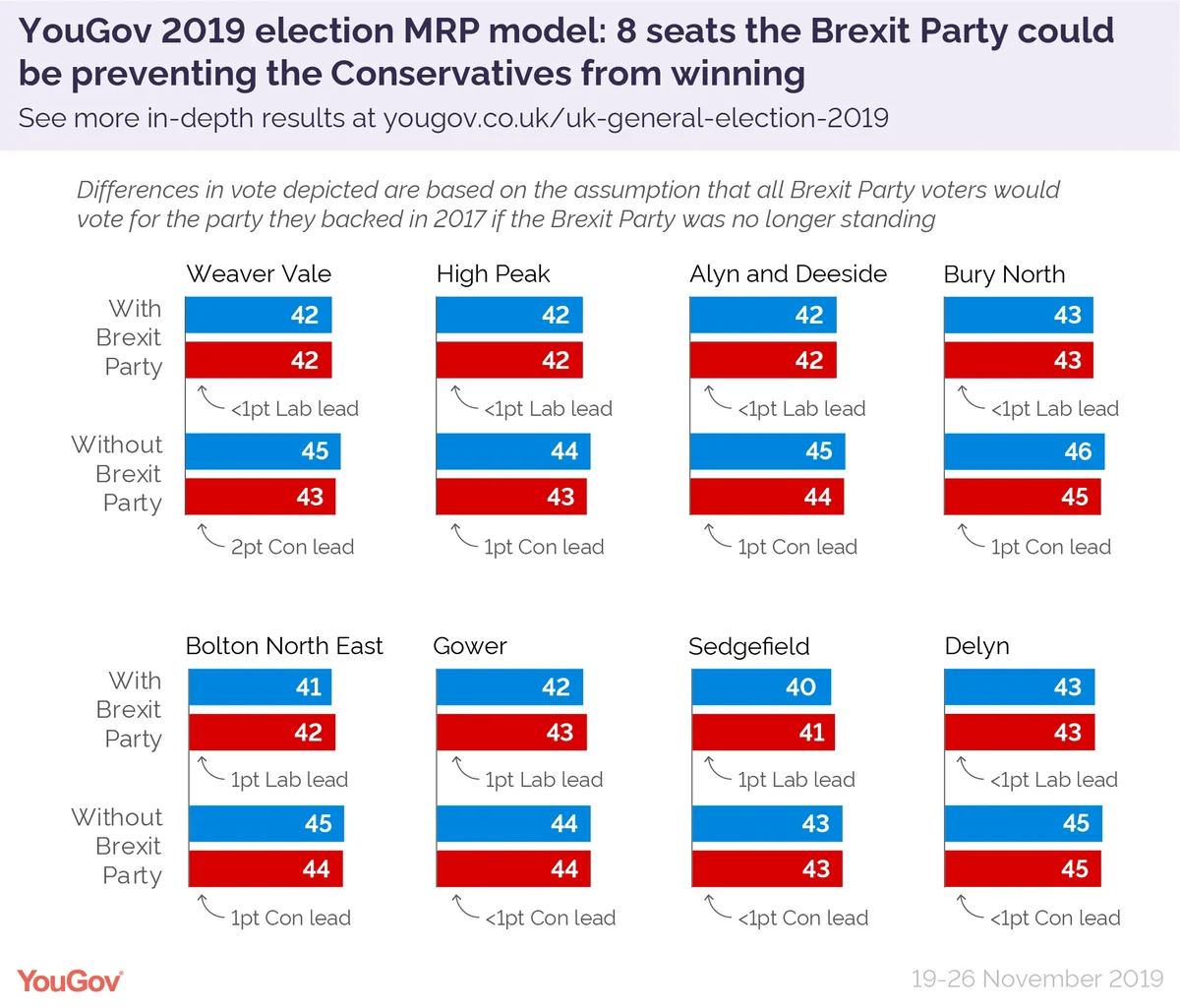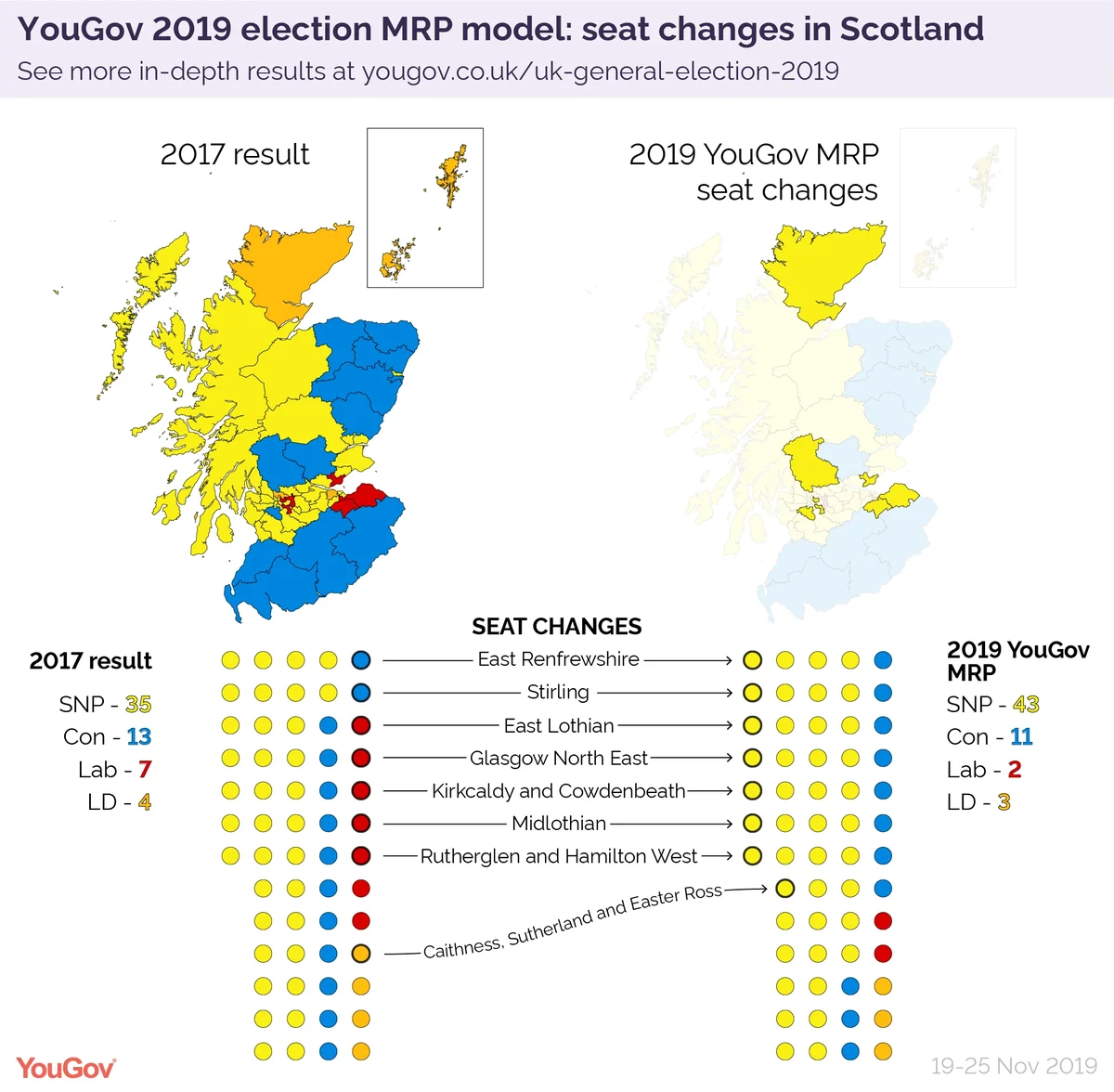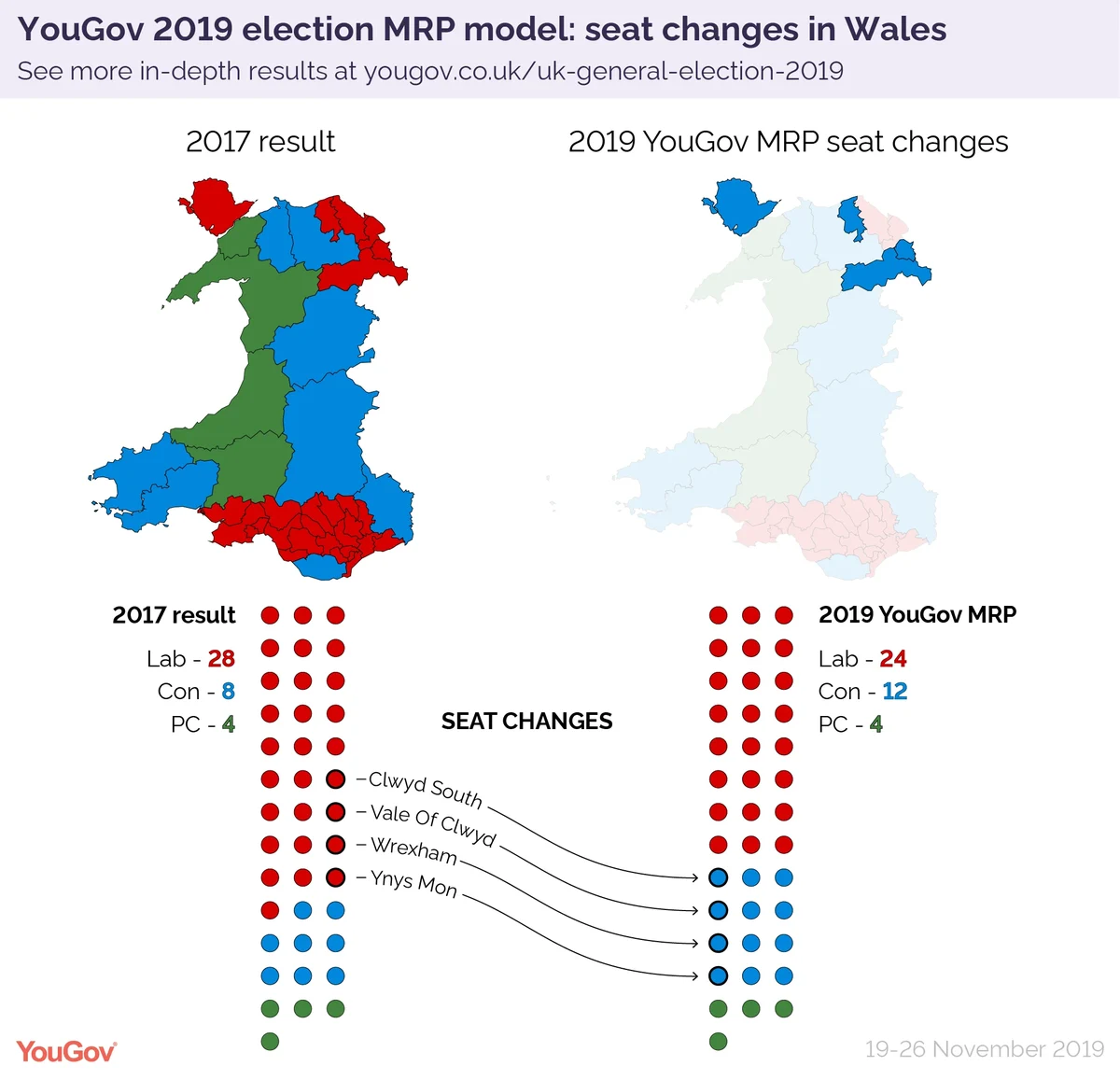The YouGov political team highlights some key findings from the new MRP results
After much anticipation, YouGov’s official 2019 general election MRP model is here. The model, which called 93% of seats correctly in 2017, currently shows the Conservatives on course for a sizable majority.
Were the election held tomorrow, the Tories would win 359 seats (42 more than they took in 2017) and 43% of the vote (around the same as last time). In terms of seats won, this would be the Conservatives’ best performance since 1987.
Meanwhile, Labour are set to lose 51 seats – falling from 262 seats in 2017 to 211 now – and taking 32% of the vote (a nine percentage point decrease). In terms of seats won this would be the party’s worst performance since 1983.
While Anthony Wells provides a broad look at the topline results – including an outline of how the model works – here, below are some of the main take-outs from YouGov’s 2019 general election MRP model.
Which seats are changing hands?
The current model has the Conservatives gaining 47 seats; 44 of which are from Labour, two are from the Lib Dems, as well as the former Speaker’s seat of Buckingham returning to the Conservative fold.
The SNP are on course to secure a further eight seats, although crucially for the Tories’ chance of securing their majority, only two come from Boris Johnson’s party (Stirling, and East Renfrewshire). By contrast, Labour are set to lose five seats to the SNP, with the Lib Dems losing one.
The spectre of first past the post returns to haunt the Lib Dems once more, with their six percentage point increase in the vote since 2017 being rewarded with just four new seats. Three come from the Conservatives (including St Albans where an 11 point Tory lead in 2017 is set to become a 12 point Lib Dem lead this time), and one from Labour.
Labour are on course to not take any new seats, and also lose an additional seat because of Lindsay Hoyle’s elevation to the Speaker’s chair.
Labour’s “Red Wall” is crumbling – including Tom Watson’s old seat
Most seats changing hands are ones that Labour won in 2017 that are now set to be taken by the Conservatives. What happens in these constituencies is the most important dynamic in deciding whether Boris Johnson has a majority, and how large it ends up being.
Of the 76 Labour-held seats where they lead the Tories by fewer than 8,000 votes, Jeremy Corbyn’s party is currently behind in 43 of them. The Conservatives also lead by 1 point in Leigh in Greater Manchester, which Labour won last time with a majority of 9,554.
But the swing is not uniform across all of these seats. There are much larger swings in the more pro-leave seats, allowing the Tories to gain Tom Watson’s old seat of West Bromwich East (9% swing) and win in Caroline Flint’s constituency of Don Valley (9% swing).
But some Labour MPs are being saved by the “sophomore surge”
At the other end of the scale there are seats where Labour is set to hold on, despite tiny majorities in 2017. These tend to be in southern ‘Remainy’ seats, but in many cases they are seats where incumbent Labour MPs are up for re-election for the first time and are benefiting from a “sophomore surge” (where such candidates get a slightly higher voter share than would otherwise be expected).
This has been a fairly consistent theme in election results for the past 35 years, most notably in 2001 when there was a 2% swing against Labour nationally but the Tories only managed to pick up four seats.
In the 28 seats that Labour gained from the Tories in 2017 where the incumbent is standing again, the swing against the party has been just 2% on average, as opposed to double that across the country as a whole.
This means Labour are holding on in seats like Battersea (where they are 9 points ahead), or Portsmouth South (where they are 7 points ahead).
Another notable example is Canterbury, which Labour took by just 187 votes in 2017 despite the seat previously being held by the Tories since 1918. The current model shows Labour holding the seat, on 47% of the vote, with the Conservatives on 43%.
The Lib Dems: extra votes but only one more seat – all defectors set to lose
The election campaign has not gone as well for the Lib Dems as they would have hoped, and this model will not bring any additional good news. Despite their vote having nearly doubled to 14% from 8% in 2017, they are only up by one seat.
The nature of Lib Dem seats looks to be changing, with the party’s support base looking different than it did in the past. The party has improved its vote share among Remainers (now on 23%), but has only 4% support amongst Leavers.
This means the party is set to gain the ‘Remain-y’ seats of St Albans, Richmond Park, Sheffield Hallam, and Cheltenham. However, it’s on course to lose its more ‘Leave-y’ seats of Eastbourne and North Norfolk.
The model currently shows none of the MPs who have defected to the Lib Dems in recent months winning the seats in which they are standing. Among the defectors from the Conservatives, Sarah Wollaston is 19 points behind in Totnes, Antoinette Sandbach is trailing by 33 points in Eddisbury, Philip Lee is behind by 10 points in Wokingham, and Sam Gyimah is 8 points down in Kensington.
The three Labour defectors are also struggling. Chuka Umunna is 13 points behind in Cities of London and Westminster, Luciana Berger is 18 points behind in Finchley and Golders Green, and Angela Smith is trailing by 34 points in Altrincham and Sale West.
However it is worth noting that there could be local elements in play in these seats, which the model might not be picking up.
The Brexit Party are still hurting the Tories more in Labour-held marginals
While it’s almost impossible to fully assess these things, YouGov’s MRP model seems to suggest that the Brexit Party is hurting the Conservatives more than Labour in some neck-and-neck marginals where Nigel Farage’s party is running.
For example, in Bury North our model shows the race is too close to call between Labour and the Conservatives. Here, for every one vote the Brexit party is taking from Labour it is taking two from the Conservatives (4% of 2017 Labour voters plan to back Nigel Farage’s party compared to 8% of 2017 Tory voters).
If the Brexit Party didn’t stand, and all of these voters returned to the party they backed in 2017, this would boost the Conservatives’ total vote share in these seats by 3% and Labour’s vote share by only 2%, handing the seat to the Conservatives.
In fact, in all of the five Labour-held seats that our model currently shows as being neck-and-neck between Labour and the Tories, the Brexit Party is hurting the Conservatives slightly more than Labour and seemingly denting the Tories’ chances of winning there.
In Sedgefield, Bolton North East, and Gower, constituencies where Labour currently has a one-point lead, the Brexit party currently looks to be holding the Conservatives back. However, the data suggests that the influence of the Brexit party is not large enough to make a difference in any seats where Labour are ahead by two or more points.
The Remain Alliance is failing to help the Green Party
Earlier in the campaign, the Green Party, Liberal Democrats and Plaid Cymru agreed to form a ‘Remain Alliance’ election pact across 60 seats. In these constituencies – such as Ynys Mon, Bristol West and Dulwich and West Norwood – only one candidate from the three parties would stand. This was to prevent the pro-Remain vote being split and thereby boosting the chance of electoral success amongst these parties.
However, our model suggests that this pact is doing little to boost the Greens’ chances of increasing their presence in the House of Commons.
For example, despite making clear progress in Bristol West, it looks like Labour will still win the seat comfortably – taking over 60% of the vote share compared to just shy of 20% for the Green Party. Dulwich and West Norwood shows the party rivalling the Conservatives for second place, but they do not currently have enough support to take the seat from Labour.
However, Caroline Lucas is set to comfortably hold her seat in Brighton Pavilion, with our model showing the party currently taking over 60% of the vote share.
Independents are finding it difficult to pick up seats
All three candidates for the Independent Group for Change look set to lose their seats to the parties they defected from earlier this year. While Anna Soubry is the best performing candidate of the three as it stands, she is still a distant third in Broxtowe. Gavin Shuker, who is standing as an independent candidate in Luton South, currently trails the Labour candidate by some distance.
Elsewhere, David Gauke, the ex-Conservative cabinet minister standing as an independent candidate in South West Hertfordshire, looks set to lose. It is a similar story for veteran parliamentarian Frank Field in Birkenhead, a seat he’d previously held for Labour since 1979. And while Dominic Grieve is picking up a large number of votes in Beaconsfield he is still a long way off winning such a safe Conservative seat.
East Devon looks to be most likely seat to elect an independent candidate. Claire Wright is standing there for the third time and is currently in second place – 6 points behind the Conservative candidate.
An important caveat to make is that because our MRP is modelling seats using aggregated data, it may not pick up on specific localised factors. If these factors are significant enough to influence how people vote, they may be understated in our model. This is particularly important when looking at independent candidates as they are not comparable to other candidates and parties.
Scotland
Headline seat numbers: SNP 43, Con 11, Lib Dem 3, Lab 2
The SNP are set to make notable gains in Scotland, but fall short of their performance in 2015.
The model shows Labour is currently performing poorly across Scotland, meaning it is set to lose five of their seven seats to the SNP. It is set to cling on in Coatbridge, Chryston and Bellshill by one point, and comfortably hold Edinburgh South.
The swing from Conservative to SNP is much narrower as both parties have made gains nationally. As a result, the Conservatives are currently set to hold on to 11 of the 13 seats they took in 2017, losing only Stirling and East Renfrewshire to the SNP.
However, currently the races in many Conservative-held seats are tight. In Gordon, Ochil and South Perthshire, Aberdeen South, Ayr, Carrick and Cumnock, Moray, Angus, and East Renfrewshire the margin ranges from a 1 point SNP lead to a 5 point Conservative lead.
Elsewhere, two of the four Lib Dem-held seats look set to be close tussles with the SNP. The SNP is currently one point ahead in Caithness, Sutherland and Easter Ross, while Edinburgh West is neck-and-neck. North East Fife, where the SNP beat the Lib Dems by just two votes in 2017, is set to be tight again, with the SNP ahead by 2 points.
Wales
Headline seats: Lab 24, Con 12, Plaid Cymru 4
It is possible Labour could lose all of their North Wales seats, with the six they hold in this region looking like tight contests with the Conservatives.
The Tories currently have a 4 point lead in Wrexham, a seat Labour has won at every election since 1922. Four other North Wales Labour seats – Vale of Clwyd, Delyn, Alyn and Deeside, and Clwyd South – could also move into the Conservative column, with the situation across these constituencies currently ranging from a 2 point Tory lead, to both parties being tied. In Ynys Mon, there is a three-way battle between Labour, Conservatives and Plaid Cymru, with the Tories currently 7 points ahead.
In South Wales, Labour are currently on course to keep all of its seats, although the party’s lead is just 2 points and 1 point respectively in Bridgend and Gower. Plaid Cymru seem to be holding onto all four of the seats they currently hold, including Ceredigion, which they gained narrowly in 2017.
The Liberal Democrats by-election triumph in Brecon and Radnorshire looks to be short-lived. Even aided by the Remain Alliance pact with the Greens and Plaid Cymru, the Conservatives are set to win back the seat.
Few “big beasts” look set to lose their seats
Despite the number of seats changing hands, few ‘big beasts’ are set to be felled. Zac Goldsmith looks set to lose his Richmond Park seat to the Lib Dems (part of the Remain Alliance), while Shadow Cabinet members Sue Hayman (Defra) and Lesley Laird (Scotland) are in line to be beaten in Workington and Kirkcaldy & Cowdenbeath respectively.
More notable are two Labour losses in the Midlands. One is the West Bromwich East seat that Labour deputy Leader Tom Watson is vacating, and which Labour won by a 20 point margin at the last election. The other is Bolsover, which long-standing Labour backbencher Dennis Skinner has held since 1970 and which Labour won by an 11 point margin in 2017.
It’s also worth noting that seven Labour MPs who backed Boris Johnson’s deal in October – Laura Smith, Jon Cruddas, Caroline Flint, Melanie Onn, Jo Platt, Gareth Snell and Ruth Smeeth – are set to lose to Conservative candidates.
YouGov’s official MRP model does not point to Dominic Raab and Boris Johnson being in danger. While Raab is the fifth most vulnerable cabinet minister, he holds an 11 point lead over his Lib Dem opponent in Esher and Walton. Meanwhile Boris Johnson holds a 13 point lead over Labour in Uxbridge.
On the other hand, DEFRA secretary Theresa Villiers is vulnerable, with her Chipping Barnet constituency on a knife edge with both the Tories and Labour on 41% apiece. DfID Secretary Alok Sharma and Scotland Secretary Alister Jack’s seats are also marginal, but currently enjoy more comfortable 9 point leads over their main rivals.





